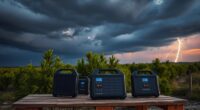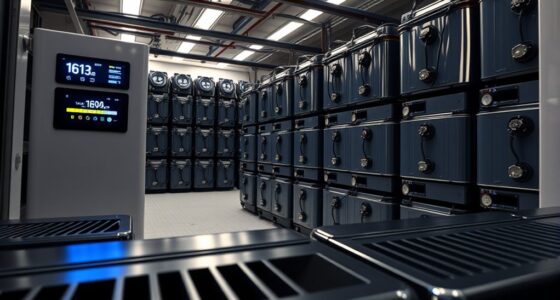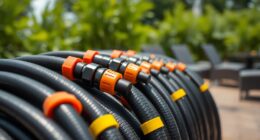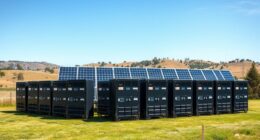To choose the right power station for your truck camping, first assess your daily energy needs, including devices and appliances, and consider capacity, battery life, and port types. Pick a portable, easy-to-use model with sufficient runtime and plug options for your gear. Budget wisely by investing in reliable, long-lasting units that suit your eco preferences. Continue exploring to discover how balancing features and costs guarantees your off-grid adventures stay powered.
Key Takeaways
- Assess your daily energy needs, including lights, devices, and small appliances, to determine the required power capacity.
- Choose a power station with compatible ports (USB, AC, DC) and sufficient wattage for your devices.
- Prioritize portability, size, and weight for easy transport and fitting in your truck or camping setup.
- Consider long-term reliability, durability, and ease of maintenance over initial cost for sustained performance.
- Explore solar-compatible options and advanced batteries (like lithium-ion) for off-grid recharging and extended use.
Understanding Your Power Needs

Before hitting the road, it’s vital to understand how much power you’ll need to keep your truck camping setup running smoothly. Start by evaluating your daily energy consumption, including lights, small appliances, and charging devices. Solar efficiency plays an important role; higher-efficiency panels generate more power even in limited sunlight, reducing your reliance on other power sources. Additionally, consider the inverter types available—pure sine wave inverters provide cleaner power for sensitive electronics, while modified sine inverters are more affordable but less efficient. Recognizing the importance of power output capacity helps ensure your system can handle all your devices’ energy demands. By understanding your power needs, selecting high-efficiency solar panels, and choosing the right inverter type, you’ll guarantee your truck camping setup stays energized and reliable throughout your adventure. Planning ahead prevents power shortages and keeps your trip enjoyable.
Types of Power Stations for Truck Camping
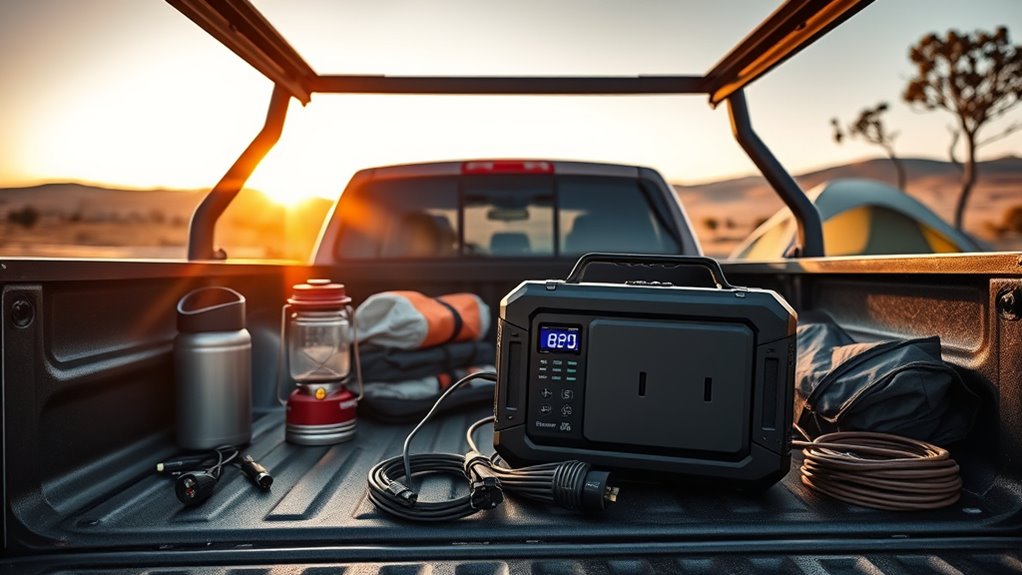
Choosing the right power station can make or break your truck camping experience. There are three main types to contemplate:
- Portable Battery Packs: Compact, lightweight, and perfect for short trips. They often include built-in solar panels for recharging.
- Inverter Generators: These provide steady AC power and are suitable for running larger appliances. They come with various inverter types that offer quieter operation and cleaner power output.
- Solar-Powered Stations: Rely entirely on solar panels for charging, making them eco-friendly and silent. They’re ideal if you want independence from fuel sources and plan to stay off-grid.
Each type offers different benefits depending on your power needs, portability, and eco preferences. Power station efficiency is an important factor to consider when selecting the best option for your camping setup.
Key Features to Consider When Choosing a Power Station
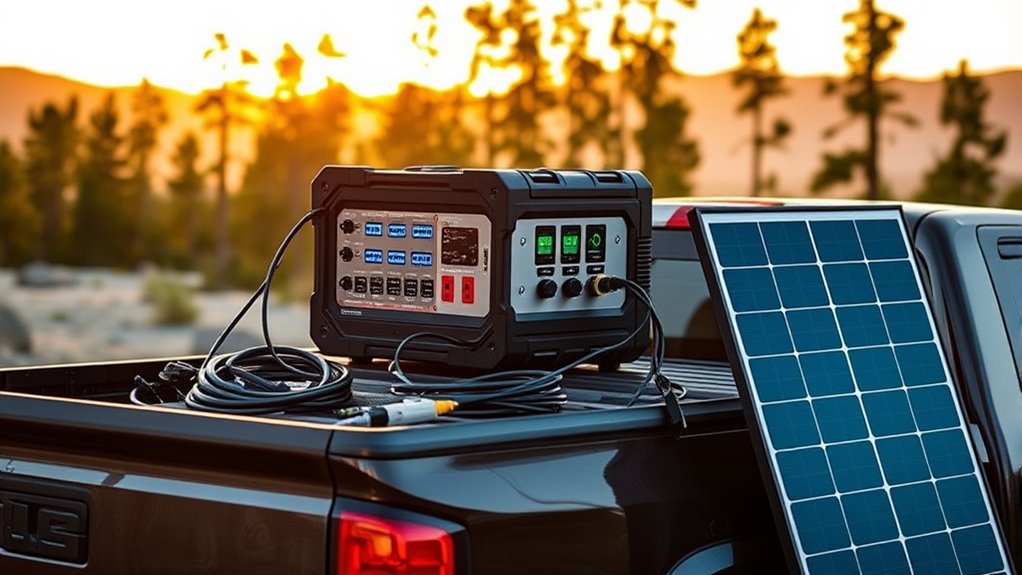
When selecting a power station, you need to take into account its power capacity and how long it can run your devices. Make sure it has the right ports and is compatible with your gear for easy charging. Finally, choose a model that’s portable and fits comfortably in your truck without sacrificing power. Additionally, consider vetted options, which have been reviewed for safety and reliability to ensure optimal performance during your trips.
Power Capacity and Runtime
Understanding the power capacity and runtime of a portable power station is essential because it determines how long your devices can run and how much energy you can draw from it. To choose the right unit, consider these factors:
- Capacity (Wh): Larger capacity means longer runtime and the ability to power more devices simultaneously.
- Inverter efficiency: A higher efficiency ensures less energy loss during power conversion, maximizing runtime.
- Solar compatibility: If you plan to recharge via solar panels, verify the station’s compatibility to maintain a steady energy source.
- Automation and smart features: Many modern power stations incorporate automation technologies to optimize energy use and provide real-time monitoring, enhancing user control and efficiency.
Balancing capacity with inverter efficiency guarantees your power station meets your needs without unnecessary weight or expense. Pay attention to solar compatibility if you’ll be off-grid long-term, and opt for a unit with sufficient capacity to keep your devices powered throughout your trip.
Port Selection and Compatibility
Selecting the right power station involves carefully examining its port options and compatibility with your devices. You want to verify it has the right outlet types for your gadgets, such as AC, USB-A, USB-C, or DC ports. Check if the station supports solar compatibility if you plan to recharge using solar panels, allowing for versatile off-grid use. Compatibility with your devices’ power requirements is essential—some outlets deliver higher wattages for larger appliances. Make sure the ports are easily accessible and sufficient for your needs. Pay attention to the number of ports and their placement to simplify your setup. Choosing a station with diverse and compatible port options guarantees you can power everything reliably, whether it’s small electronics or larger appliances. Additionally, understanding port selection and compatibility is crucial to ensure your power station integrates seamlessly with your outdoor setup.
Portability and Size
Choosing a power station that’s portable and appropriately sized makes your truck camping setup more convenient and manageable. A compact unit saves space and reduces weight, making it easier to transport and store. When evaluating size, consider how much power you need and whether the unit can be easily carried or stored in your vehicle. Look for options compatible with portable solar panels, which can expand your energy source efficiently. Also, pay attention to inverter types—pure sine wave inverters provide cleaner power for sensitive devices, while modified sine wave inverters are typically more affordable but less versatile. Keep these key points in mind:
- Choose a lightweight, compact design for easy transport
- Ensure compatibility with portable solar panels for extra power
- Select the right inverter type based on your device needs
- Understanding industry trends and features helps in making informed choices improve your marketability.
Assessing Capacity and Battery Life
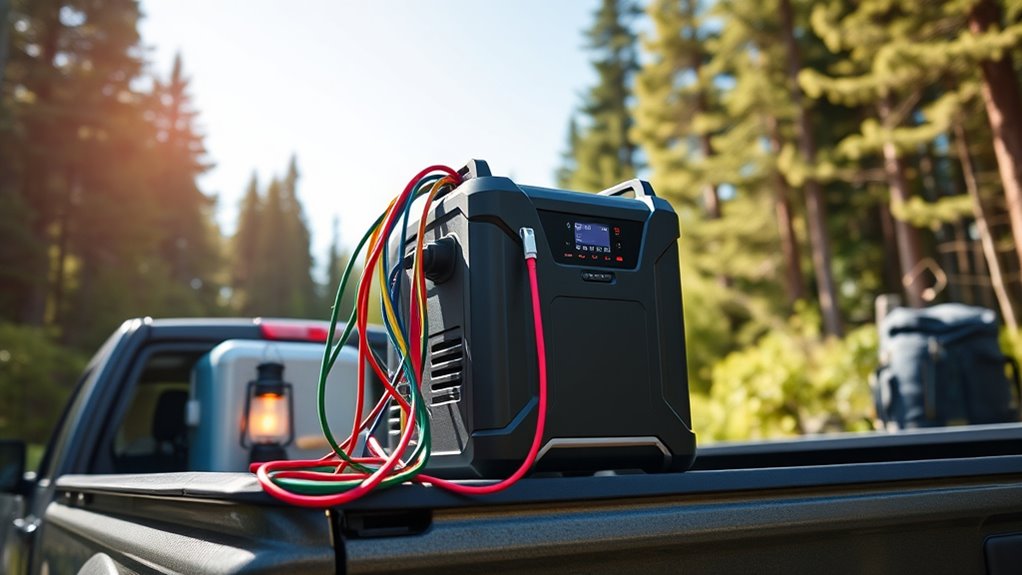
When evaluating your truck camping setup, it’s crucial to assess both the capacity of your power sources and their battery life. Start by considering how much energy you’ll need daily for devices like lights, refrigerators, and chargers. Look into the solar efficiency of your solar panels, as higher efficiency means better energy collection even in limited sunlight. Battery chemistry also plays a key role; lithium-ion batteries typically offer longer lifespan and greater capacity compared to lead-acid options. Check the amp-hour ratings to understand how long your power station can run specific devices before recharging. Combining high solar efficiency with advanced battery chemistry ensures you’ll have reliable power throughout your trip, reducing the need for frequent recharges and keeping your setup efficient and dependable. Additionally, understanding Forsale 100 can help you find affordable options for power stations and accessories.
Portability and Ease of Use
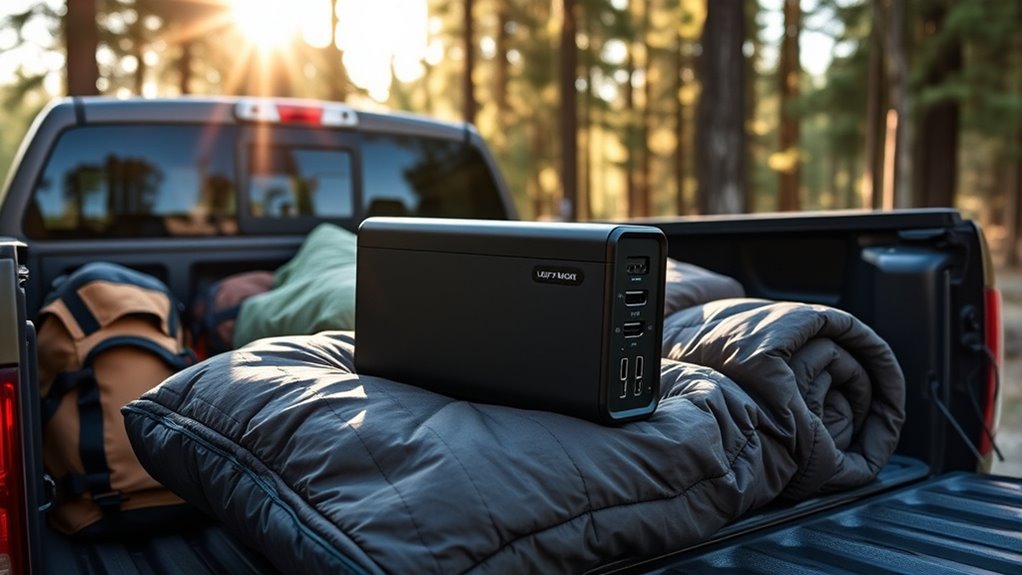
After evaluating your power sources, it’s important to contemplate how easily you can transport and operate your camping gear. Portability and ease of use are key for a smooth experience. Consider these factors:
- Size and weight: Choose a lightweight, compact power station that fits comfortably in your truck bed or cabin.
- Solar compatibility: Opt for models that support solar panels, making setup quick and providing a reliable emergency backup when needed.
- User-friendly controls: Look for intuitive interfaces with simple buttons and displays, so you can operate your power station effortlessly, even in stressful situations.
- Ease of maintenance: Selecting a model with straightforward maintenance requirements can extend the lifespan of your equipment and ensure consistent performance. Ease of maintenance
A portable, easy-to-use power station ensures you stay connected and prepared, whether for daily use or emergencies.
Budgeting and Making the Best Investment
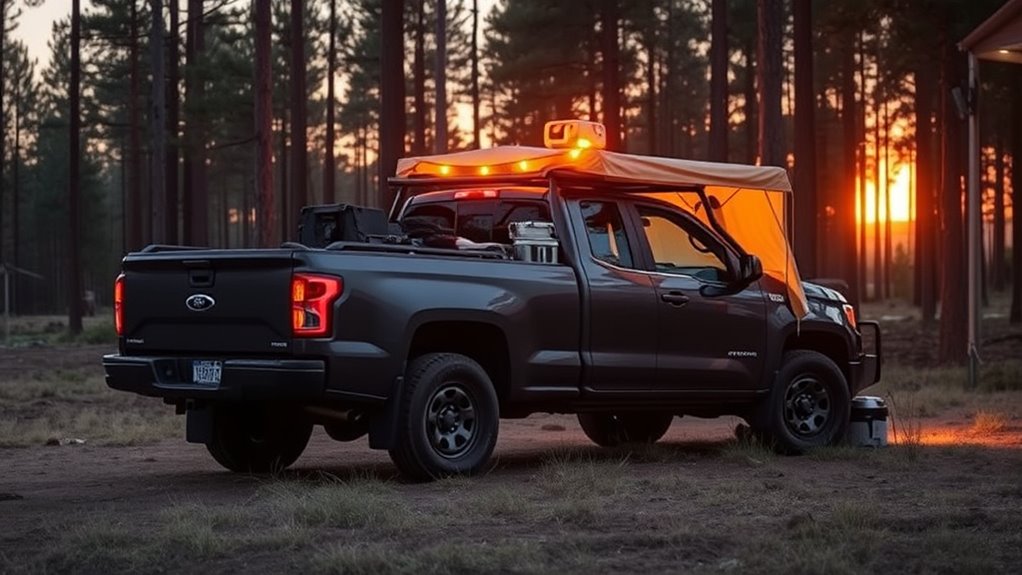
Budgeting wisely guarantees you get the most value from your investment in truck camping gear. Start by evaluating your power needs, considering how much energy you’ll require daily. Look for a power station compatible with your solar panels to maximize renewable energy use and save costs over time. Inverter compatibility is vital; ensure the station can handle your devices’ wattage to avoid overloads or needing additional equipment. While it might be tempting to go for the cheapest option, investing in a slightly higher-quality unit can offer better durability and efficiency. Keep in mind that a reliable power station isn’t just a purchase—it’s a long-term investment in your comfort and convenience on the road. Making smart choices now guarantees you’ll enjoy dependable power on every trip. Additionally, choosing a unit with proper filtering technology can help ensure cleaner air during your travels, enhancing your overall camping experience.
Frequently Asked Questions
Can I Charge My Power Station Using Solar Panels?
Yes, you can charge your power station using solar panels. Just make certain your solar panel compatibility with your portable power solutions, checking voltage and wattage specifications. Many power stations have dedicated input ports for solar charging, making it a convenient and eco-friendly way to keep your power station topped up. This setup is ideal for truck camping, giving you reliable power on the go without relying on traditional outlets.
How Long Does a Typical Power Station Last on a Full Charge?
A typical power station lasts for about 3 to 5 years, depending on its battery lifespan and charging cycles. You might get 300 to 500 full charge cycles from it before performance drops. To extend its life, avoid deep discharges and overcharging. Proper maintenance and using solar panels for charging can help maximize your power station’s longevity, ensuring reliable energy during your adventures.
Are Power Stations Safe to Use Indoors?
You might wonder if power stations are safe indoors. They generally are, but you should guarantee proper indoor ventilation to prevent buildup of heat or fumes. Always follow manufacturer guidelines, keep them away from flammable materials, and avoid overloading to reduce fire hazards. Using a power station indoors can be safe if you take these precautions, giving you reliable power without risking safety.
What Maintenance Is Required for a Power Station?
Think of your power station like a delicate garden that needs regular tending. You should keep it clean, avoid over-discharging the battery, and store it properly. To maximize battery lifespan, monitor charging cycles and avoid frequent deep discharges. Regularly check for any signs of wear or damage. Proper maintenance guarantees your power station remains reliable, ready to power up your adventures without unexpected surprises.
Can I Connect Multiple Devices Simultaneously?
You can connect multiple devices simultaneously, but it depends on your power station’s device compatibility and power output. Check the station’s maximum wattage to guarantee it can handle multiple gadgets without overload. Use appropriate outlets or adapters for different devices, and avoid exceeding the power limit. This way, you’ll keep everything running smoothly without risking damage or power interruptions. Always refer to your power station’s specifications for safe, effective use.
Conclusion
Now that you know what to look for, choosing the right power station becomes a walk in the park. By understanding your needs, comparing features, and sticking to your budget, you’ll find a reliable partner for your truck camping adventures. Remember, it’s better to be safe than sorry, so don’t cut corners. With the right power station in hand, you’ll be all set to hit the road and enjoy the great outdoors without a hitch.

